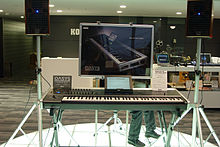| OASYS | |
|---|---|
 Korg OASYS | |
| Manufacturer | Korg |
| Dates | 2005–2009 |
| Price | $8,000–$8,500 |
| Technical specifications | |
| Polyphony | 172 for HD-1, CX-3, & PolysixEX; 96 for AL-1; 52 for MOD-7; 48 for STR-1 & MS-20EX (all maximum; may vary depending on other sounding voices and effects) |
| Timbrality | 16 |
| Oscillator | depends on synthesis engine |
| Synthesis type | PCM, Wave Sequencing, Vector, Physical Modelling, Sampler, Analog Modelling |
| Filter | depends on synthesis engine |
| Aftertouch expression | yes |
| Velocity expression | yes |
| Storage memory | 1GB RAM, upgradable to 2GB. No physical ROM. Preloaded samples include 314MB "ROM" (loaded into RAM automatically at startup), and optionally-loaded 313MB EXs1 "ROM Expansion" & 503MB EXs2 "Concert Grand Piano." 0MB to 1.5GB available for user samples, depending on memory configuration and loaded EXs. Internal 40GB HDD. |
| Effects | 12 insert, 2 master, 2 total |
| Hardware | 2.8 GHz Intel Pentium 4 processor |
| Input/output | |
| Keyboard | 76 or 88-key |
| Left-hand control | 2x Joystick, 2x Switch, Ribbon, KARMA |
| External control | MIDI |
The Korg OASYS is a workstation synthesizer released in early 2005, 1 year after the successful Korg Triton Extreme. Unlike the Triton series, the OASYS uses a custom Linux operating system that was designed to be arbitrarily expandable via software updates, with its functionality limited only by the PC-like hardware.
OASYS was a software implementation of the research project that ultimately resulted in the OASYS PCI, a DSP card which offered multiple synthesis engines.[1] The original OASYS keyboard concept had to be scrapped because of excessive production costs and limitations of then-current technology.[2]
Production of the OASYS was officially discontinued in April 2009. Korg sold just over 3000 units worldwide.[3] The final software update was released on November 24, 2009.[4]
In 2011, Korg Kronos, a successor of Korg OASYS, was introduced at that year's NAMM Show.[5]
- ^ "OASYS PCI Home". Archived from the original on 2010-07-20. Retrieved 2010-07-30.
- ^ "Korg OASYS: Part 1". Sound On Sound. November 2005. Retrieved 22 June 2018.
- ^ karma-lab.com
- ^ "korgusers.net". Archived from the original on 2011-07-17. Retrieved 2010-08-20.
- ^ "NAMM 2011: Korg Kronos Music Workstation". Sound On Sound. 2011-01-16.